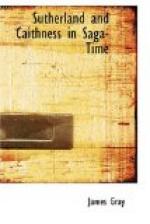Hakon’s fleet then sailed round the Mull of Deerness into the roadstead of Ragnvaldsvoe, in the north of South Ronaldsay, which is now known either as St. Margaret’s Hope or possibly as Widewall Bay in Scapa Flow, and it was while it was there that the annular eclipse of the sun, ascertained by astronomical calculation[14] to have taken place on the 5th August 1263, was reported by the writer of the Saga to have been seen by him. While the fleet was here, it appeared that the Orkney contingent of ships which Hakon had commanded to join him, were not “boun” or ready for sea, and Jarl Magnus accordingly “stayed behind” with his people in Orkney under orders to follow the main fleet.
On St. Lawrence’s day, the 10th of August 1263, Hakon weighed anchor without the jarl, or his men, and the fleet, the largest then ever seen in these waters, sailed from Ragnvaldsvoe into the Pentland Firth, and, rounding Cape Wrath on the same day, anchored in Asleifarvik, now corruptly called Aulsher-beg or Old-shore, on the west coast of the parish of Durness[15] in Sutherland. Thence the fleet ran across to the Lewis, whence it proceeded on a southerly course by Rona, into the Sound of Skye, and brought up at the Carline, now the Cailleach, Stone, in Kyleakin or the Kyle of Hakon. The Norse King was soon joined by King Magnus of Man, and Erling Ivar’s son, and Andres Nicholas’ son, and Halvard and Nicholas Tart, the last having made no land since he left Norway till he sighted the Lewis. Dougal, king of the Sudreys also joined King Hakon, and the fleet shortly afterwards reached Kerrera, near Oban in the Sound of Mull. The events which followed are recounted, in considerable detail and with much exaggeration on both sides, by Scottish and Norse chroniclers, but it is impossible to reconcile their different versions of the story of the battle of Largs. Nor does such detail, save in the result, affect Sutherland or Caithness. Suffice it to say, then, that after much fruitless negotiation between the two kings, purposely prolonged by the Scottish monarch, a severe and protracted October storm drove many of the Norse ships ashore near Largs, where the Scots attacked their crews; and five days later King Hakon withdrew, and sailed with the remnants of his starving and shattered fleet northwards by the Sound of Mull and Rum and Loch Snizort in Skye, and thence round Cape Wrath, to the Goa-fiord or Hoanfiord, which we know as Loch Erriboll, reaching it on Sunday, October 28th, 1263, in a profound calm.
On their way south, Erling Ivar’s son, Andrew Nicolas’ son, and Harvard the Red had[16] “sailed into Scotland under Dyrnes, from which they went up country, and destroyed a castle and more than twenty hamlets.” But on the return voyage the children of Heth were waiting for the invaders, and on the day[17] “of St. Simon and St. Jude, when Mass had been sung, some Scottish men, whom the Northmen had taken, came. King Hakon gave them peace and




